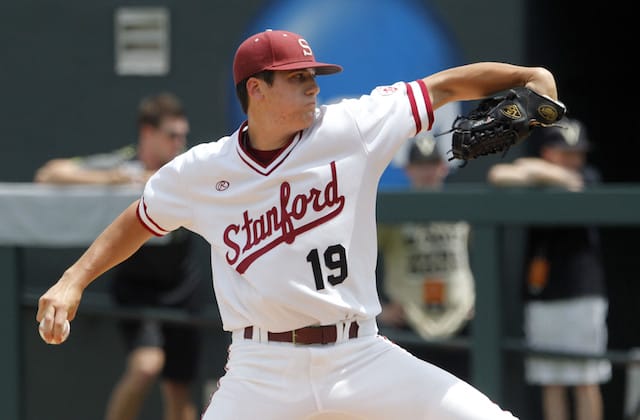With the 2016 Major League Baseball Draft beginning Thursday, we’ve reached the conclusion of the series of draft profiles. In the final, we look at some of the prospects I identified last year as my personal favorites.
Cal Quantrill, Stanford
Position: RHP
Ht/Wt: 6’3/185
B/T: Left/Right
DOB: 10/2/1995
His name should sound familiar, as his dad Paul pitched for the Dodgers in the early 2000s. Quantrill was another prospect I liked early in the draft process.
However, this was three years ago, before he spurned the New York Yankees and went to Stanford. Quantrill pitched very well in his freshman year and looked like he would a surefire first-rounder as a junior, but he hurt his elbow after just three starts in his sophomore year and had Tommy John surgery.
He hasn’t pitched in a competitive game since. Before he was hurt, Quantrill had an advanced four pitch mix. His fastball sat in the low 90s, touching the mid 90s and he commanded the pitch well.
His curveball, slider and changeup all flashed at least average, with the curve looking like his out pitch. Quantrill threw plenty of strikes and had the feel you’d expect from the son of a Major Leaguer.
It’s odd that Quantrill, who has since recovered from the procedure, hasn’t pitched. However, it makes sense if a team has already agreed to a deal with him. The rumor is that a certain Southern California team has an agreement in place to take him in the first round: the San Diego Padres.
However, it’s not confirmed and we won’t know who it is until draft day, so until then we can dream.
CONTINUE READING: High school outfielder who has room to grow
Avery Tuck, Steele Canyon High School (California)
Position(s): RF, LF
Ht/Wt: 6’5/195
B/T: Left/Right
DOB: 12/28/1997
After each year’s draft, there are two big All-Star Games: the Perfect Game All-American Classic and the Under Armour All-America Game. I always try to identify a hitter and pitcher I like for the following year’s draft. For 2016, the hitter was Tuck.
He has a pretty left-handed swing that can drive balls to the gaps and, eventually, over the fence. He’s a skinny player with a lot of room to fill out over the next five years, so the power profile is very intriguing.
Tuck has also shown an above-average time in the 60 yard dash, as well as a very strong arm, reaching 93 mph from the outfield. The issue for him has been performance.
Tuck hasn’t dominated this spring and clubs are skeptical of how ready he is for pro ball. The Dodgers have a hefty bonus pool and could throw high six figures our low seven figures at him in the later rounds. If he doesn’t sign, he’ll spend the next three years at San Diego State.
CONTINUE READING: Right-hander that may require Dodgers to go over slot
Forrest Whitley, Alamo Heights High School (Texas)
Position: RHP
Ht/Wt: 6’7/220
B/T: Right/Right
DOB: 9/15/1997
As for the pitcher who drew my attention following last year’s Perfect Game All-American Classic and Under Armour All-America Game, that was Texas righty Forrest Whitley.
Whitley stood out at the game as one of the largest competitors in attendance, listed at 6’7 and 250 lbs. His body was soft and looked like it would be high maintenance, which was the only negative I saw in his brief, one inning outing.
However, Whitley completely transformed his body this spring, firming up his frame and now weighing around 220 lbs. His fastball has been consistently in the low-to-mid 90s and features a good amount of life, running in on righties.
Whitley’s primary breaking ball is a curve that reaches the low 80s and features plenty of bite. He also has a changeup that he doesn’t need at the high school level but could develop into a third usable pitch.
While Whitley is generally considered a mid-to-first round talent, there are questions about his signability. His father reportedly sent a letter to teams expressing his son’s disinterest in turning pro. It could take $3 million to sign him, so the Dodgers (with nearly $10 million to spend this year) could go over-slot with him at Nos. 20 or 32.
